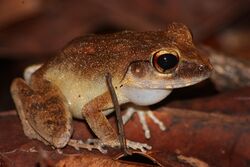Biology:Cornufer papuensis
| Cornufer papuensis | |
|---|---|

| |
| Cornufer papuensis calling on the forest floor on Normanby Island, Papua New-Guinea | |
| Scientific classification | |
| Domain: | Eukaryota |
| Kingdom: | Animalia |
| Phylum: | Chordata |
| Class: | Amphibia |
| Order: | Anura |
| Family: | Ceratobatrachidae |
| Genus: | Cornufer |
| Species: | C. papuensis
|
| Binomial name | |
| Cornufer papuensis (Meyer, 1875)
| |
| Synonyms[2] | |
| |
Cornufer papuensis is a species of frog in the family Ceratobatrachidae. It is found in the northern parts of New Guinea and in many surrounding islands, including the Bismarck Archipelago, D'Entrecasteaux Islands, Trobriand Islands (Papua New Guinea), and Maluku Islands including Sula Islands and Seram Island (Indonesia).[1][2] Common name Papua wrinkled ground frog has been coined for the species.[2]
Description
Males can grow to 46 mm (1.8 in) and females to 64 mm (2.5 in) in snout–vent length. The toes have a trace of basal webbing. The dorsum has numerous short skin folds. There are three dorsal color patterns morphs: unicolored, two-striped (dorsolateral stripes), and one-striped (vertebral stripe).[3]
The male advertisement call is loud and consists of partly clustered pulses. Note length is 96–157 ms and inter-note length is 130–306 ms. Note repetition rate is relatively low at 4 per second.[4]
Habitat and conservation
Cornufer papuensis is a very common species in much of its range and occurs in a variety of habitats from primary rain forest to secondary regrowth, gardens, and other heavily disturbed habitats. It is a lowland species occurring at elevations below 1,200 m (3,900 ft).[1] Males call at night, but sometimes start well before sunset. They call from the floor of the rain forest, usually taking an exposed or slightly sheltered position on the leaf litter, but may sometimes call from low shrubs.[3]
There are no known threats to this widespread and adaptable species. Furthermore, it occurs in many protected areas.[1]
References
- ↑ 1.0 1.1 1.2 1.3 IUCN SSC Amphibian Specialist Group (2020). "Cornufer papuensis". IUCN Red List of Threatened Species 2020: e.T58474A149654112. doi:10.2305/IUCN.UK.2020-3.RLTS.T58474A149654112.en. https://www.iucnredlist.org/species/58474/149654112. Retrieved 17 November 2021.
- ↑ 2.0 2.1 2.2 Frost, Darrel R. (2018). "Cornufer papuensis (Meyer, 1875)". Amphibian Species of the World: an Online Reference. Version 6.0. American Museum of Natural History. http://research.amnh.org/vz/herpetology/amphibia/Amphibia/Anura/Ceratobatrachidae/Ceratobatrachinae/Cornufer/Cornufer-papuensis. Retrieved 21 April 2018.
- ↑ 3.0 3.1 Zweifel, Richard G. (1969). "Frogs of the genus Platymantis (Ranidae) in New Guinea, with the description of a new species". American Museum Novitates (2374): 1–19. http://digitallibrary.amnh.org/handle/2246/2584.
- ↑ Günther, R. (2015). "Description of two new taxa of the ceratobatrachid genus Platymantis from western New Guinea (Amphibia, Anura)". Vertebrate Zoology 65 (1): 101–116. doi:10.3897/vz.65.e31509. http://www.senckenberg.de/files/content/forschung/publikationen/vertebratezoology/vz65-1/10_vertebrate_zoology_65-1_guenther_101-116.pdf.
Wikidata ☰ Q28057451 entry
 |


